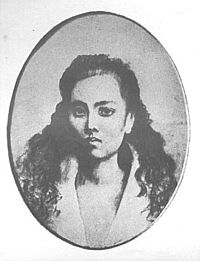- María Clara
-
 A crayon sketch of Leonor Rivera, the basis of the Maria Clara character in José Rizal's Noli Me Tangere.
A crayon sketch of Leonor Rivera, the basis of the Maria Clara character in José Rizal's Noli Me Tangere.
María Clara, whose full name is María Clara de los Santos, Rizal also described her as Inang Pilipinas (Mother Philippines) is the mestiza heroine in Noli Me Tangere, a novel by José Rizal, the national hero of the Republic of the Philippines. Maria Clara is the childhood sweetheart and fiancée of Noli Me Tangere 's hero, Juan Crisóstomo Ibarra y Magsalin, the son of Don Rafael Ibarra. Although raised as Santiago "Kapitan Tiyago" de los Santos’s daughter, Maria Clara is the illegitimate offspring of Father Dámaso, a Spanish friar, and Doña Pía Alba. Doña Alba is the wife of Kapitan Tiyago, who are both native Filipinos. Father Damaso (also known as Padre Damaso) is known to Maria Clara as a godfather. Maria Clara never met her mother because Doña Alba died during the delivery of her daughter. She grew under the guidance and supervision of Tía Isabél, Kapitan Tiyago's cousin. While her boyfriend Crisostomo Ibarra was travelling in Europe, Kapitan Tiyago sent her to the Beaterio de Santa Clara, a convent where she developed femininity under religion. Later in the novel, Maria Clara discovers the truth that Father Damaso is her biological father.
Contents
Description
In the novel, Maria Clara is regarded as the most beautiful and widely celebrated lady in the town of San Diego. Maria Clara, being religious, the epitome of virtue, “demure and self-effacing” and endowed with beauty, grace, and charm, was promoted by Rizal as the “ideal image”[1] of a Filipino woman who deserves to be placed on the “pedestal of male honor”. In Chapter 5 of Noli Me Tangere, Maria Clara and her traits were further described by Rizal as an “Oriental decoration” with “downcast” eyes and a “pure soul”.[2]
Basis and adaptation
Rizal based the fictional character of Maria Clara from his real life girlfriend and cousin Leonor Rivera. Although praised and idolized, Maria Clara's chaste, "masochistic", and "easily fainting" character had also been criticized as the "greatest misfortune that has befallen the Filipina in the last one hundred years".[1][3] In fashion in the Philippines, Maria Clara's name has become the eponym for a Filipino national dress for females known as the Maria Clara gown, an attire connected to Maria Clara’s character as a maiden who is delicate, feminine, self-assured, and with a sense of identity.[4]
maria clara's song by dr.jose rizal
- Sweet the hours in the native country,
- where friendly shines the sun above!
- Life is the breeze that sweeps the meadows;
- tranquil is death; most tender, love.
- Warm kisses on the lips are playing
- as we awake to mother's face:
- the arms are seeking to embrace her,
- the eyes are smiling as they gaze.
- How sweet to die for the native country,
- where friendly shines the sun above!
- Death is the breeze for him who has
- no country, no mother, and no love!
References
- ^ a b Vartti, Riitta (editor). Preface to the Finnish anthology Tulikärpänen - filippiiniläisiä novelleja (Firefly - Filipino Short Stories), Kääntöpiiri: Helsinki, Finland 2001/2007
- ^ Yoder, Robert L. Philippine Heroines of the Revolution: Maria Clara they were not, univie.ac.at, July 16, 1998
- ^ The History of Filipino Women's Writings, an article from Firefly - Filipino Short Stories (Tulikärpänen - filippiiniläisiä novelleja), 2001 / 2007, retrieved on: April 2, 2010
- ^ Moreno, Jose "Pitoy". Costume at the Fin de Siecle - Maria Clara, Philippine Costume, koleksyon.com
External links
- Description of María Clara at en.wikibooks.org
- Full text in Tagalog ("Ang Awit ni Maria Clara")
- Full text in Spanish ("Canto de Maria")
- Full text in English ("The Song of Maria Clara")
Categories:- Works by José Rizal
- Hero
- Novel characters
- Noli Me Tangere (novel)
Wikimedia Foundation. 2010.
